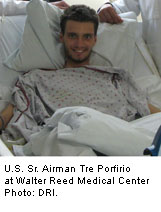
WEDNESDAY, April 21 (HealthDay News) — In the first operation of its kind, a wounded soldier whose damaged pancreas had to be removed was able to have his own insulin-producing islet cells transplanted back into him, sparing him from a life with the most severe form of type 1 diabetes.
In November 2009, 21-year-old Senior Airman Tre Porfirio was serving in a remote area of Afghanistan when an insurgent who had been pretending to be a soldier in the Afghan army shot him three times at close range with a high-velocity rifle.
After undergoing two surgeries in the field to stop the bleeding, Porfirio was transferred to the Walter Reed Army Medical Center in Washington, D.C. As part of the surgery in the field, a portion of Porfirio’s stomach, the gallbladder, the duodenum, and a section of his pancreas had been removed.
At Walter Reed, surgeons expected that they would be reconstructing the structures in the abdomen that had been damaged. However, they quickly discovered that the remaining portion of the pancreas was leaking pancreatic enzymes that were dissolving parts of other organs and blood vessels, according to their report in the April 22 issue of the New England Journal of Medicine.
“When I went into surgery with Tre, my intention was to reconnect everything, but I discovered a very dire, dangerous situation,” said Dr. Craig Shriver, Walter Reed’s chief of general surgery.
“I knew I would now have to remove the remainder of his pancreas, but I also knew that leads to a life-threatening form of diabetes. The pancreas makes insulin and glucagon, which take out the extremes of very high and very low blood sugar,” Shriver explained.
Because he didn’t want to leave this soldier with this life-threatening condition, Shriver consulted with his Walter Reed colleague, transplant surgeon Dr. Rahul Jindal.
Jindal said that Porfirio could receive a pancreas transplant from a matched donor at a later date, but that would require lifelong use of immune-suppressing medications. Another option, Jindal said, was a transplant using Porfirio’s own islet cells — cells within the pancreas that produce insulin and glucagon. The procedure is known as autologous islet cell transplantion. Such a procedure had never been done in this type of situation, Jindal said.
“I called one of my colleagues in the transplant field, Dr. Camillo Ricordi [chief of cellular transplantation at the University of Miami Diabetes Research Institute], and he was ready to give it a try. We had about half the pancreas left, which we removed and sent to Miami, as we would an organ for donation,” said Jindal.
In the meantime, because it was the evening before Thanksgiving and many people had gone home early, Ricordi had to re-assemble a team of technologists to harvest Porfirio’s islet cells. Islet cell transplantation was initially developed with the hope of curing type 1 diabetes. And, while it’s temporarily helpful for those with the disease, the autoimmune attack that caused diabetes in the first place eventually destroys the transplanted cells as well. Researchers have also used islet cell transplants to help people with chronic pancreatitis.
“I was concerned,” said Ricordi. “It was the first time we’d done a remote procedure where there isn’t a human cell processing center on the receiving end. But, I thought no matter, what we could give back in islet cells would be a good help. I didn’t predict that we’d be able to get him off insulin therapy completely.”
Less than 24 hours later, the harvested islet cells were back at Walter Reed, ready to be infused into Porfirio. According to Ricordi, the procedure to infuse the islet cells into the liver is relatively simple. They’re infused into the portal vein in the liver, and then they “seed in” the liver and eventually take up their own blood supply from that organ. Once in place, these cells begin producing insulin and glucagon.
“I want to say it was three days after the surgery before it all hit me what was going on,” said Porfirio. “It’s amazing that they could do something like that.”
Said Walter Reed’s Shriver: “We sort of made this up on the fly. It took three people with strong expertise to come up with this plan on Thanksgiving eve, and six technologists willing to give up their time to help a wounded warrior. Seeing Tre alive now and getting well is really the payoff.”
Remarkably, Porfirio’s blood sugar levels are now normal and he doesn’t require any insulin therapy. He still has several more surgeries to go, according to Shriver, in addition to the 15 major procedures he’s also had to reconstruct other areas of his abdomen.
In March, Porfirio was back in the hospital for a much happier occasion, the birth of his first son.
And the improvised transplant procedure may one day lead to a new treatment approach that might “prevent diabetes and secondary complications if even a small portion of [the] pancreas can be salvaged,” the doctors wrote in the journal.
More information
For more on Tre Porfirio’s story, watch this video from the Diabetes Research Institute.

